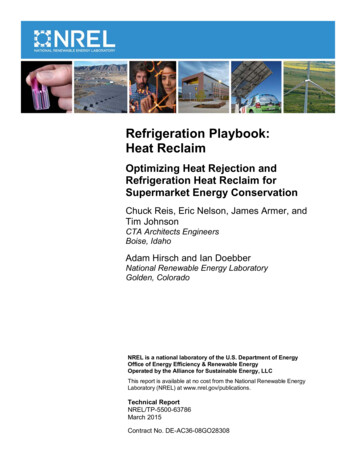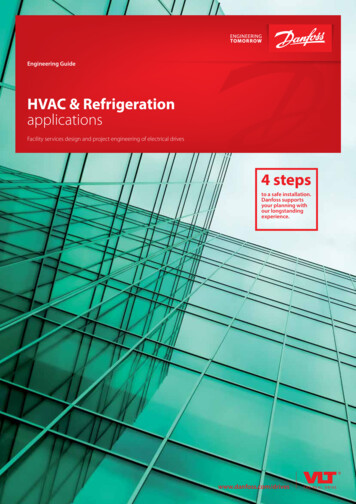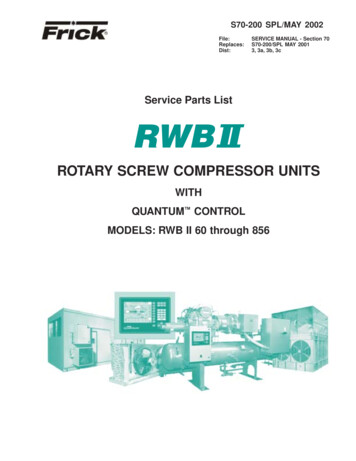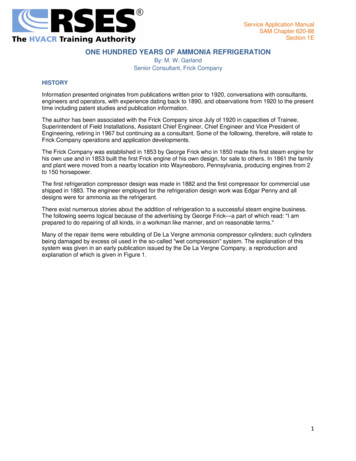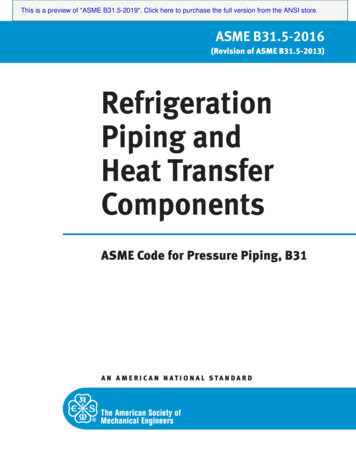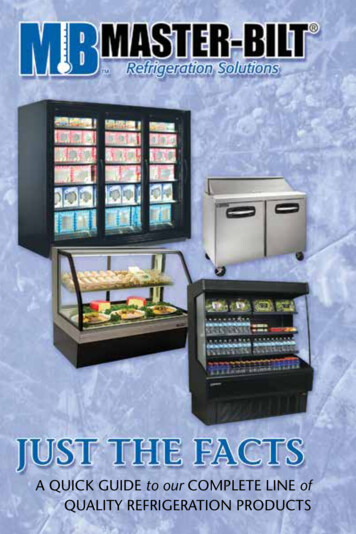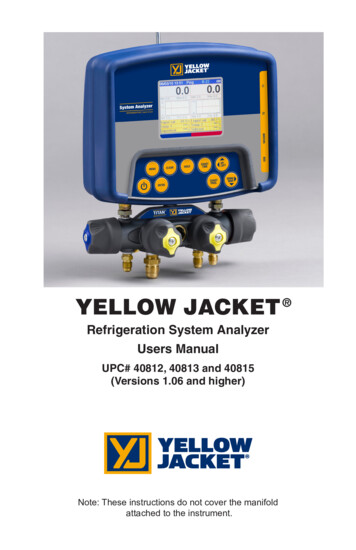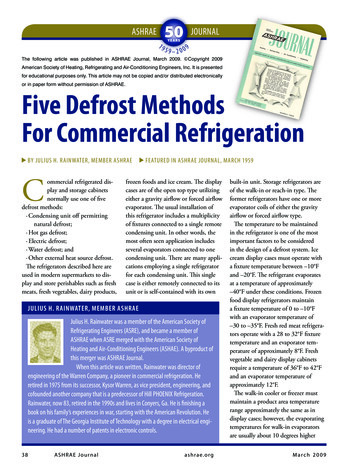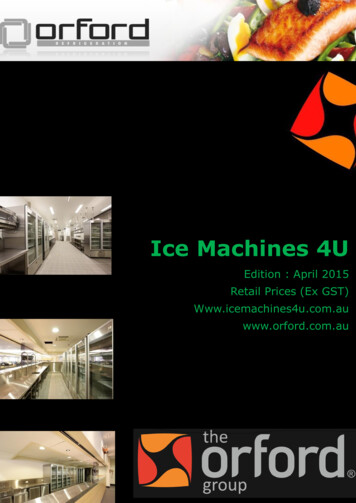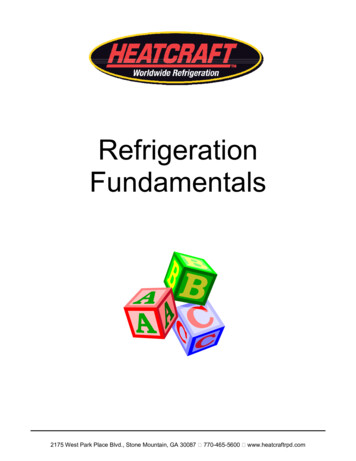
Transcription
RefrigerationFundamentals2175 West Park Place Blvd., Stone Mountain, GA 30087770-465-5600www.heatcraftrpd.com
Table of ContentsBASIC Principles . . . . . . . . . . . . . . . . . . . . . . . . . . . . . . . . Pages 1-16Heat – energy form . . . . . . . . . . . . . . . . . . . . . . . . . . . . . Page 1Measuring Heat . . . . . . . . . . . . . . . . . . . . . . . . . . . . . . . . Page 2Heat Flow . . . . . . . . . . . . . . . . . . . . . . . . . . . . . . . . . . Pages 2-3Physical States . . . . . . . . . . . . . . . . . . . . . . . . . . . . . . Pages 3-4Latent vs. Sensible . . . . . . . . . . . . . . . . . . . . . . . . . . . Pages 4-5Refrigeration process . . . . . . . . . . . . . . . . . . . . . . . . Pages 6-7Saturation, Superheated, Subcooling . . . . . . . . . . . . . . . Page 8Pressure/Temperature . . . . . . . . . . . . . . . . . . . . . . . . Page 9-11Refrigeration Cycle . . . . . . . . . . . . . . . . . . . . . . . . . . . . . Pages 12-24Compressor . . . . . . . . . . . . . . . . . . . . . . . . . . . . . . Pages 12-14Flow Control . . . . . . . . . . . . . . . . . . . . . . . . . . . . . . Pages 15-17Evaporator . . . . . . . . . . . . . . . . . . . . . . . . . . . . . . . Pages 18-20Condenser . . . . . . . . . . . . . . . . . . . . . . . . . . . . . . . Pages 20-22Accessories & Options . . . . . . . . . . . . . . . . . . . . . . Pages 23-27Glossary . . . . . . . . . . . . . . . . . . . . . . . . . . . . . . . . . Pages 28-33Typical Commercial Refrigeration SystemExpansionLiquid LineValveSolenoid ValveFilterDrierLiquidLineSightGlassHead PressureControl enserPage ii
INTRODUCTIONThe information in this manual is meant for entry-level personnel to the commercialrefrigeration industry to improve their understanding of the fundamentals of basic refrigerationprinciples. There are no specific technical prerequisites required prior to beginning this coursematerial.The course is structured with the more basic and simple content presented first. It is importantthat the student have a good understanding of the presented material before continuing tomore complex content, which may require a thorough grasp of previously covered material.This “building block” technique should allow students to quickly scan the material forunderstanding, begin more intense use of the material where understanding is known to belacking, or refer to earlier content to improve understanding of more familiar topics. Furtherassistance is available by contacting Heatcraft Training Department in Stone Mountain or yourlocal Heatcraft sales representative.Course objectives are to broaden useful knowledge of commercial refrigeration principles toimprove efficiency on the job, allow for more flexibility in job duties, and increase the value ofthe student to their company and themselves. This manual should provide exposure to newresources and reinforce doctrines or beliefs, which the student may have already adopted.Simple terms and language will be used throughout the manual to assure that the studentclearly comprehends the material. As the student progresses through the manual, morecomplex definitions and principles will be presented in the simplest terms possible. Our aim isto transfer information to the user in a manner easily understood.“When promulgating your esoteric cogitations or articulating your superficialsentimentalities and amicable philosophical and psychological observations,beware of platitudinous ponderosity. Let your verbal evaporations and lucidity,intelligibility and veracious vivacity without rodomontade or thespian bombast.Sedulously avoid all polysyllabic profundity, pompous propensity and sophomoricvacuity.” --- translation: Don’t use big words or confusing terms!Page iii
BASIC PrinciplesIceCreamGoesHereIn practice, the refrigeration process musttransfer heat from one body to anotherbody. Usually, the heat is simply dumpedinto the outdoor air or down the drain whereit is not objectionable. Heat reclaim, heatrecovery or energy conservation occurswhen the heat is sent to an area where it isneeded or desired.BeerGoesHereMost of us have some ideas concerning thepurpose of refrigeration and whatrefrigeration does. The illustration above isa consumer’s understanding ofrefrigeration. Your customers may not needto go beyond this simple understanding ofrefrigeration. However, they may expectyou to have a much greater ‘in-depth’understanding of refrigeration to help themsolve their cooling needs.To be able to provide your customers withcooling solutions, you will need to have afirm grasp of the fundamental principles ofbasic refrigeration. This manual will helpguide you through your quest to improveyour knowledge of commercial refrigeration.What is refrigeration?The basic purpose of refrigeration is toremove heat from an area where it is notwanted. Your customers may needrefrigeration to cool something that is asource of revenue for them. Normally thissomething is a perishable product or aprocess to prepare a product to be sold.They are only concerned with removing theheat from their sellable product and will relyon you to satisfy this cooling need.Since refrigeration deals completely withthe transfer of heat, to better understandhow the refrigeration process works, it isnecessary to first understand the nature ofHEAT. Then we can control the transferand removal of heat to reduce and maintainthe temperature of a space or materialbelow its natural surrounding temperature.What is heat?Heat is a form of energy like electricity. Itcomes to us from the sun and is present inevery body on the earth. Like all otherenergy forms, the laws of physics govern it.Thermodynamics is the field of science thatstudies and deals with the mechanicalaction of heat. Simply stated, heat is work,and work is heat.From the first law of thermodynamics welearn that heat cannot be created ordestroyed. Heat can be converted fromone energy form to another and is nevercontent to remain stationary or static. It isknown as the energy in transfer and neverstands still and is always on the move.All things above absolute zero (-459 F or-273 C) contain heat. Absolute zero is thetemperature at which all atoms are at theirslowest oscillation and is the coldest anymaterial can be. Scientists have not beenable to create this condition in laboratoriesor identify where it exists in the universe.Page 1
BASIC PrinciplesHow is heat measured?As a form of energy, heat is intangible andcannot to be measured directly. It can bemeasured only by measuring the effect ithas on a material, such as a change intemperature, state, size, color, etc. Thismeasurement is sometimes referred to aswork, heat content or quantity of heat.The total heat content of an object ismeasured in BTUs or calories based onthese definitions: BTU (British Thermal Unit) is theamount of heat required to change 1pound of water by 1 F at 1 atmosphere.Lighting a kitchen matchis equivalent to releasing1 BTU of energy. Calorie is the amount of heat requiredto change 1 gram of water 1 C at 1atmosphere.The heat content of an object does notdetermine its temperature.Temperature is a property of matter thatindicates the concentration or intensity ofheat in a material. Higher intensities ofheat have the atoms oscillating quickly, andthe material is considered hot or warm.Lower intensities of heat have atomsoscillating slower with the materialconsidered cold or cool.Cold is simply the absence of heat.Removing heat from a material makes itcooler or colder. An instrument used tomeasure temperature is a thermometer,which has a scale to indicate intensity.WaterBoils212 F100 C671 R373 KWaterFreezes32 F0 C492 R273 KAbsoluteZero-459 F-273 C0 R0 KTemperature scales are based on effectsof heat on water with references to boilingand freezing points of water. One of twobasic scales is normally used.The Fahrenheit temperature scale haswater boiling at 212 and freezing at 32 with absolute zero at –459 . The Celsiustemperature scale has water boiling at 100 and freezing at 0 with absolute zero at–273 .Scientists and engineers use the Kelvinand Rankin scales with 0 reference pointat absolute zero. Kelvin scales uses Celsiusincrements, and Rankin uses Fahrenheitincrements.How heat flowsThe second law of thermodynamics statesthat heat always moves from the warmerbody to the colder object. Heat cannotmove from the colder to the warmer object.There must be a temperature difference forheat to flow from one material to another.Like water, it will always seek its own level.Page 2
BASIC PrinciplesType of Material – The material separatingthe bodies through which the heat mustpass can either promote or retard the speedof heat movement. Conductors are a typeof material, which will let heat pass throughthem easily and quickly. Insulators,however, will hinder or decrease the flow ofheat through them. Example: Aluminumfins are used on cooling coils as conductorinstead of plastic fins insulation in walls tokeep heat out of coolers and freezers.There are three ways heat flows, passes,moves or transfers between bodies: Conduction – heat passes by directcontact between the bodies, frommolecule to molecule. Convection – heat flows throughavailable medias (such as fluids orgases), by riding piggyback on themoving molecule between the bodies. Radiation – heat moves on waves ofenergy carried by photons of light in theinfrared and visible portions of theelectromagnetic spectrum and does notrely on molecules.Factors of heat flowThe speed or rate of heat transfer betweenbodies is influenced by several factors.Temperature Difference (TD) – One of themost prominent of these factors is TD ortemperature difference. If the TD betweenobjects is great, heat will move quickly fromthe warmer object to the cooler one, and ifthe TD is small, heat will flow slowly.Without a temperature difference, no heattransfers. Example: Turn system thermostatdown to cool off people or products faster.Surface Area – The amount of surfaceaffects rate of transfer more surfaceexposure allows from faster heat flow.Example: A drink cools quicker withcrushed or shaved ice than larger icecubes. Consider a 100-pound ball of meatvs. (400) ¼ pound patties which one coolsdown faster in the same room conditions?Exercise:Place one of your hands on a table or desknear you. It should feel cool to your touch.This is because the surface temperature ofyour hand is warmer than the table or desk.Keep it there for a minute. The heat fromyour hand should be flowing into the tableor desk raising its temperature and loweringyour hand’s temperature. Now place yourhands together. The onethat was on the table ordesk should feel cool toyour other hand. Heattransfer has taken placethrough conduction.How heat affects change of stateMost substances can exist in a solid, liquidor gaseous (vapor) physical state. Theycan also change from one state to anotherthrough heating or cooling.The physical state change of a materialfrom liquid to vapor is called evaporation(or boiling.) The material changes from aliquid to a vapor as it absorbs heat beyondits boiling point, but the temperature staysconstant. A great amount of heat is neededto release the molecular bonds or attractionof the liquid.Page 3
BASIC PrinciplesChanging state in the opposite directionfrom vapor to liquid is called condensation.As the vapor rejects heat below its boilingpoint, it changes into a liquid. The heat itloses to change state is just as great.Example: cooking beans on Pike’s Peak Beans cook at 203 F(95 C) Water boils at 186 F(85.6 C) onPike’s Peak (14,100 ft above sealevel)Fusion occurs when a material rejects heatbelow its melting/fusion point, as it changesfrom liquid to solid state. The reciprocalchange from solid to liquid form, or melting,is a result of absorbing heat beyond itsmelting point. The same amount of heat isrejected or absorbed to cause the changeof physical state for fusion or melting.Placing the beans in a pot of water over thecamp fire or stove will result in the waterbeing boiled off before the beans arecooked, and the beans will be burned. Apressure cooker must beused to raise thepressure exerted on thewater to allow water toboil above bean’scooking temperature forthe beans to cook.Sublimation occurs when a materialchanges from solid to vapor without turningto a liquid. An example of this is dry ice.There is also a relationship betweentemperature and pressure of a materialinside a sealed pressure vessel. If there isvapor and liquid both present, the pressurewill always relate to the same temperaturefor that material. Pressure-temperaturetables and charts are available for mostgaseous refrigerants used in commercialrefrigeration systems.Pressure/Temperature RelationshipsThe boiling and melting points at whichmaterials change physical state areinfluenced by the pressures exerted onthem. For any one substance, its boilingpoint temperature is the same and remainsconstant, under a fixed pressure.Example: Water boils at 212 F at sea levelor 1 atmosphere where the weight of theatmosphere above the earth is exerting14.7 pounds per square inch. But at higheraltitudes, there are fewer atmospheres andless pressure being exerted, and water willboil at a lower temperature because lowersurface tension will allow the molecules toescape at a lower velocity.As pressure increases, the saturation pointincreases changing the boiling andcondensing temperatures, and visa versa,as the pressure decreases so does thesaturation point less vapor/surface tensionon molecules to maintain bond/attraction.Latent Heat and Sensible HeatThere are two types of heat categorized bythe effect heat has on a material to eitherchange its temperature or change itsphysical state.Sensible Heat – indicates heat absorbed orrejected by a material that accompanies orcauses a change in temperature. Thischange can be detected by the sense oftouch and measured with a thermometer.Example: 10 lbs. of water at 45 F wi
Refrigeration Fundamentals 2175 West Park Place Blvd., Stone Mountain, GA 30087 770-465-5600 www.heatcraftrpd.com



